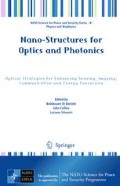Abstract
The dominant features in the UV/visible spectra of metallic nanoparticles are governed by collective oscillations of valence electrons. These resonances are called localized surface plasmon (LSP) and have positions, widths and intensities that depends strongly on the nanoparticle’s geometry and environment but also on the nature of the probing excitation. When one is interested in coupled nanoparticles, the plasmon modes of these systems can be described with an hybridization scheme (Prodan et al. Science 302(5644):419–422, 2003). With help of this approach, modes can be classified in “bright” or “dark” mode according to whether they have a net dipole moment. In the last case, the mode cannot be excited with traditional optical excitation but one has to use a focused beam of fast electrons having electric field with low spatial extension that allows local stimulation (Nelayah et al. Nat Phys 3:348–353, 2007). Here, we are interested in the simulation of the extinction and electron energy loss (EEL) spectra of isolated and coupled metallic particles. To achieve this, we have developed a new approach based on the Discrete-Dipole Approximation (DDA) (Draine, Astrophys J 333:848–872, 1988; Geuquet and Henrard, Ultramicroscopy 110:1075–1080, 2010) that uses eigenvectors of the particle’s propagator to make a truncated basis for physical quantities (Guillaume et al. Phys Rev B 88(245439), 2013). The response of the cluster of particles is then obtained by adding interaction terms which account for multiple scattering between the particles.
Similar content being viewed by others
Keywords
- Discrete-dipole approximation
- Localized plasmon
- Metallic nanoparticle
- Coupling
- Hybridization
- Electron energy-loss spectroscopy
- Optical extinction
The dominant features in the UV/visible spectra of metallic nanoparticles are governed by collective oscillations of valence electrons. These resonances are called localized surface plasmon (LSP) and have positions, widths and intensities that depends strongly on the nanoparticle’s geometry and environment but also on the nature of the probing excitation. When one is interested in coupled nanoparticles, the plasmon modes of these systems can be described with an hybridization scheme (Prodan et al. Science 302(5644):419–422, 2003). With help of this approach, modes can be classified in “bright” or “dark” mode according to whether they have a net dipole moment. In the last case, the mode cannot be excited with traditional optical excitation but one has to use a focused beam of fast electrons having electric field with low spatial extension that allows local stimulation (Nelayah et al. Nat Phys 3:348–353, 2007). Here, we are interested in the simulation of the extinction and electron energy loss (EEL) spectra of isolated and coupled metallic particles. To achieve this, we have developed a new approach based on the Discrete-Dipole Approximation (DDA) (Draine, Astrophys J 333:848–872, 1988; Geuquet and Henrard, Ultramicroscopy 110:1075–1080, 2010) that uses eigenvectors of the particle’s propagator to make a truncated basis for physical quantities (Guillaume et al. Phys Rev B 88(245439), 2013). The response of the cluster of particles is then obtained by adding interaction terms which account for multiple scattering between the particles.
Author information
Authors and Affiliations
Corresponding author
Editor information
Editors and Affiliations
Rights and permissions
Copyright information
© 2015 Springer Science+Business Media Dordrecht
About this paper
Cite this paper
Guillaume, SO., García de Abajo, F.J., Henrard, L. (2015). An Eigenvector-Expansion Method for Localized Plasmon Modes: Application to Extinction and Electron Energy Loss Spectra of Isolated and Coupled Metallic Nanoparticles. In: Di Bartolo, B., Collins, J., Silvestri, L. (eds) Nano-Structures for Optics and Photonics. NATO Science for Peace and Security Series B: Physics and Biophysics. Springer, Dordrecht. https://doi.org/10.1007/978-94-017-9133-5_44
Download citation
DOI: https://doi.org/10.1007/978-94-017-9133-5_44
Published:
Publisher Name: Springer, Dordrecht
Print ISBN: 978-94-017-9132-8
Online ISBN: 978-94-017-9133-5
eBook Packages: Physics and AstronomyPhysics and Astronomy (R0)




